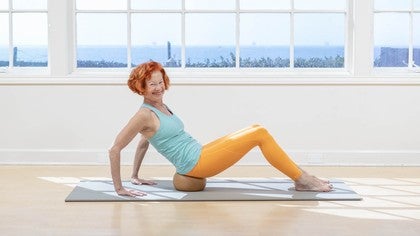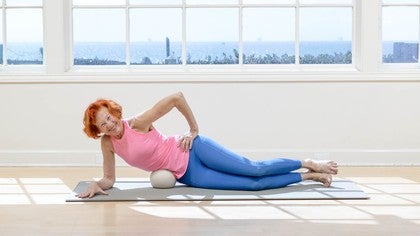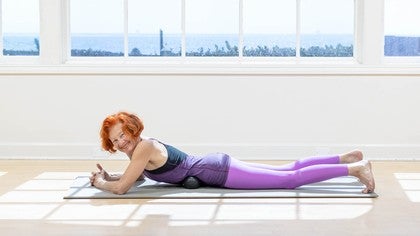Description
Props Needed: Gold Yamuna USA® Ball or something equilvent
About This Video
Transcript
Read Full Transcript
Welcome to rolling up the spine. In Pilates, we're very preoccupied with articulation of the spine and getting that mobility between each bone. And with this technique, we address that very specifically. And of course, we also open up the whole nervous system because the nervous system does run from the brain all the way down through the spinal column. And making space and movement and mobility powers up the nervous system.
It's like, you're charging it up, and it brings in state of relaxation. And it's a wonderful, wonderful basic technique for the body. Before you start, I wanted to talk about the size of the balls. No, there's not one specific size. I am 5'6".
I like to work with a ball that's about this size to give you a concept. And if you are a smaller person, you may want to work with a smaller ball. If there is degeneration of the spine, some kind of surgery, compressed discs, bulging discs that are not in an acute stage or any kind of osteoporosis or osteopenia, you always work with a softer, bigger ball because it's highly therapeutic. If you work with something too hard, it is not as highly recommended, let me put it this way. So be very sensitive.
The pressure in this ball that I will be working with today as you can see is quite soft. I like softness because it allows me to relax more into it and receive the pressure. So we will start on the right side. I always start on the right side, so I have a system and I don't forget which side I'm working on and where my focus is. We will start right at the sit bone, which is below the spine.
But because it's a big ball, you can feel the midline. You can feel the area of the pelvic floor and the beginning access into the spinal column. So just take a moment to settle in. Remember, we're always softening bone first. We're waking it up.
If you listen deeply to your own body, you can feel a point where there's kind of this sigh. Everything relaxes. There's a receiving and an acceptance. So as we are very much in a process of healing and restoration of the body with this work, you want to pay attention and relax externally, internally, and focus inward. It's not an extroverted practice.
It's really an introverted practice. So let's take a deep breath in and send the breath into the bones at the base of the pelvis. And as you breathe out, feel everything relax. And then, bring your body slightly forward. So what's happening here?
Now, you're into the side of the tail as well. The pressure isn't directly into the tail, but it's that area between the sit bone and the tailbone. And because it's a big ball, it's kind of global. And we're beginning the stimulation of the spinal column. So take a breath in here. (breathes audibly) As you breathe out, a gentle firmness of the abdominal area.
You're creating stability and then seeing how much you can sink into the ball and create pressure and the beginning of decompression. Breathing in, breathing out, and have a look at your pelvis too. Do you look more or less even? A lot of strange patterns can start to kick in here. Another breath in. (breathes audibly) Breath out and roll further forward.
So now, you're into the side of the sacrum. And again, take a moment. Feel what's happening here. Big breath in. Breath out. Really stimulate the sacrum. Let yourself sink.
Imagine this area waking up and starting to have its own pulse, its own life force coming back into it. One more breath in. (breathes audibly) Breathe all the way down into the base of the spine. You can feel it when you do it. Breathe out and then roll further forward, and bring the pelvis down. So now, you're coming to the floor.
And have a look at your pelvis. We all have twists and turns. Can you even yourself out? And shift your hands. Big breath in. Breath out and press.
Now, really make sure. Are you pressing that low part of the spine into the ball and attempting to relax? Take a moment and feel in. Are you tight? Are you loose? Are you kind of toned?
And are you creating traction, very gentle traction on the muscles on the side of the spine? Another breath in. Breath out and just hang out here for a minute and wait. Lumbar spine gets very tight, very congested. You want to create support in the front of the body.
And you can even test. We're Pilates people, we should be quite strong. Can you actually stabilize yourself from the abdominal to create this length? Can you actually elongate the spinal column and receive the pressure at the same time? From here, tuck your pelvis up a little bit.
So we're at posterior tilt. Roll a little bit further down the spine or up the spine with the ball, downwards with your bottom. And then, lower the pelvis again. The ball should be in the waist area moving into the ribs on the right side of the spine. So yes, you're spanning the full spine, but the focus is into the right side.
Have a look. Are you even or are you starting to twist? Great place to start to find places where we have compromised patterns. Take a breath in. As you breathe out, lengthen.
Notice I'm elongating. Feel like you have a string that's pulling you up and then lengthening you down. So take a moment and just hang here. If your head or neck feels tight, you can always support your head a little bit. Make sure you feel even, and please do focus on the stability that's coming in the front of the body while you're creating this length and relaxation in the back.
One more breath in. Breathe into the area where the ball is. Create movement in your own vertebra. As you breathe out, create length, pressure, and just softening into the area. Listen into your own body and notice what you're feeling.
And then, curl the tail. So see if you can really get the tail to articulate. And very slowly, peel it up a little bit, so you're creating traction in the low spine. And roll further up. So now, we have come to just below the shoulder blade area.
Again, look at your pelvis, look at your ribcage. The ball is on the right side, so there may be some funny things going on. Do the best you can to even yourself out, but stay focused with the pressure into the ball. Big breath in. Create length. And as you breathe out, imagine that you're making yourself longer.
You're not draping and collapsing. So I'm not releasing the body, I'm tractioning the spine and softening the area that is over the ball, is putting pressure into the ball. Big breath in. (breathes audibly) And breathe into the ball. And then, as you breathe out, imagine widening your ribs. They are spreading sideways, they're expanding.
Each rib is becoming broader, longer, and wider. Lift up again. Roll further up. So now, we're in the area of the shoulder blades. Again, check to see are you even? Do you feel balanced?
You can have both hands behind your head if it helps. Big breath in. Lengthen the spinal column and allow yourself to sink into the ball. Breath in again. Lengthen. Pull the abdomen towards the spine to create traction and length everywhere.
And then, soften down and listen into your own body. Over and over, pay attention to the sensations. Sometimes, you can have a slight, tight, hard, resistive sensation and you just stay there and breathe. You can feel it completely shift. Think of yourself like a jellyfish that's just getting back to being jelly again.
And allow yourself to open up and let go of deep, deep, tight patterns that may be floating around. Another breath in. Another breath out, creating this beautiful length. Lift the hips, lengthen the spine, and roll up. So now, we're right against the full shoulder blade on the right side.
So right side of the spine in the area between the spine and the shoulder blades. Nice pressure, nice length. You may even feel the effect of this into the sternum and the chest. That's really good. That means a lot of your body's starting to interconnect and have a network that talks to each other.
Big breath in. Lengthen the back of the neck out and press into the ball. Breath in. Breath out. And it's a fine dance.
Pressing into the ball and relaxing is very personal. Sometimes, you may just need to relax and not use any directed active force. And sometimes, it serves to have the more focused intensity. So there's no one way to do the work, but it is like a canvas. You're creating your own therapy as you pay attention and listen to what's right for you today.
One more time, breathing out, lengthening the neck as well. Lift the hips. Roll further forward. So now, we're coming into the area of the neck. So bring yourself down. It's covering the top of the ribcage, right where the shoulders are, into the neck.
This is where a bigger ball for my neck size and body size is fabulous. You have permission to change balls when you get to the neck because maybe a different size ball would be more appropriate for you. My neck used to be much tighter, and I always shifted to a slightly smaller ball because it fit my body better, and it allowed for more loving pressure that allowed me to release. So feel the pressure into the neck. Take a breath in.
Breath out. Really feel the head first relaxing. And then, if you put your hand on your forehead, you can push down with your hand to create that loving pressure into an area that usually gets very tight. You can also bring the chin a little bit down to feel that subtle movement in the occipital bone. And very slightly move your nose left and right like you're saying no, just to start to connecting to where there's rigidities in your neck. One more time, breath in.
Breath out and roll further down. So at this point, we should be fully in the neck on the side. Check to see that you're still pretty even. Maybe you are, maybe you're not. And allow the back of the neck to lengthen.
Notice it When I'm bringing my chin down, I'm creating more traction into the neck. And we want this. Also, allow the shoulders to move away. From here, roll your head to the right and feel that pressure into the ball, and also possibly a stretch on the left side. So we're also putting pressure now into the skull above the neck muscles and the neck bones.
Big breath in here. Breathing out and start to roll into your right side. So take your time. You're on the corner. Let your head move down and up. You can catch a lot of tightness all around the bones of the cervical spine that get grippy and possibly hold our skull in a twisted position.
Many people have their head off askew to one side as where they live, and we can begin to soften some of those patterns up and release them when we do this work. Another big breath in, into the neck. Keep the neck long and roll further around. So take your time here. You want to feel that you're putting pressure into the the bones on the side of the neck.
And again, you can move your chin back and forth, and find those spots that are a bit tight. Take a moment. You can go yes. Or no. Or look up.
Feel around the neck. And the head has so many angles, so you can do a lot. Right there. Lots of tension in my neck. So this is an area that feels good for me to hang out with. Explore your own physiology.
It's such an opportunity. You are basically moving all around the bones of the spine when you do this work, and you're creating length. So take a moment. Now, to come out, you hold your head, get the ball out, and drop your head down. So you don't want to lift your head up suddenly when you've been loosening it up.
You want to support it with your hands. So lie down for a minute. Feel your spinal column. Check in. Notice the differences.
We are over and over again noticing, becoming aware of these subtle changes that are happening all the time within us. And when we create, release an opening, we want to make, literally taking a picture of a desirable state and saying, "This is important." We usually focus on what we don't like and make a picture of this and then kind of obsess about it. We want to be obsessing about what we do want, what's positive, what's desirable. Because then, our whole physiology tends to be more attracted in that direction. And so we're influencing ourselves on many level.
We're calibrating in very subtle ways towards more optimal states of being. So notice the difference and then bring yourselves back up, and we will start the left side. And by the way, before you start, notice the difference between the right and left side of your body. It can be quite extreme now. Bring yourselves up to the sit bone on the left side and take a moment.
Here we go on the journey on the side that's left. Let yourself sink down. Feel the calibration of the bone to your tailbone, the texture of all the muscles all around there. Just kind of check in, and take a deep breath in and see if the breath can affect the bones in some way. Can you actually send the breath all the way down there and feel that resonance?
And then, as you breathe out, imagine everything spreading and expanding and just receiving the pressure. Another breath in and then breathe out. And now, we roll right between the sit bone and the tailbone, maybe the sacrum. This area can get a little bit more congested. There's a lot going on in here, so take a moment to check in and notice what your experience is.
And the pressure into the side of the tailbone is very stimulating. It actually starts to wake up the full circuit going up and down the spinal column. So take a moment to check in here. Feel the connection. And then, take a breath in and roll a little bit further forward and pay attention to your pelvis.
Notice the alignment. Are you starting to go crooked? Or can you sustain a relatively balanced shape? Big breath in. Breath out, putting pressure into the side of the sacrum.
Beginning this journey upwards, creating length in that area. Lengthen the muscles. As you breathe out, start to very slowly move up the side of the spine with the ball and feel the sit bones moving down towards the floor. So you want to roll in and get down and feel that decompression. If you do it well, you're starting to kind of elongate the whole area.
Big breath in. Send the breath into the ball and the back. And then, on the out breath, start putting pressure in and feel the stomach supporting the back. So we're having this sandwiching from the front from the abdomen, from the back from the ball, and from our focus to get long to create a lot of spaciousness healing energy and a lot of openness in this area. Breath in. Breath out.
We're moving into the lumbar spine area, this area that gets a lot of degeneration, a lot of compression. If people get older, they have thinning discs or conditions, and this is very, very therapeutic to the area. Take your time feeling in and going with what feels good for you. It could be very, very lovely. Big breath in.
Breath out, and now tuck the tail. So you lift your hips up. Find that connection to the abdomen, feel the pressure into the ball, and roll further down with your bottom so the ball is coming higher up. So it's in the waist area moving in towards the ribs on the left side. Start to notice that you're creating length in the spine.
You're elongating the whole spinal column and making space. Big breath in. Breath out, lengthening out, creating pressure. Again, breath in. Breath out and pausing to notice what's it like.
What's happening in the bones here? If you are noticing that there's sections of your back that are super blocked or you know it from different exercises that you don't roll well there, this is a great way to start to really soften up and get in touch with the deeper story and how to shift it. One more time, breath in. Breath out. Lift your hips a little bit and roll further down with the bottom, which means the ball is now, in my case, at the base of the, coming into the area of the shoulder blades, a more dense part of the ribcage.
Check your pelvis again. Check your abdomen. You may not be perfect, but see what you can do. If your neck is beginning to hurt you or you feel you need support, you can always hold your head with your hands. Breath in, breathe into the ball. Lengthen the spinal column and elongate the whole back.
Again, breath in. Lengthen the spine. Check that the abdomen is long. So you don't want to be opening up one area of the back at the expense of the other. One more time.
Breathing out. Curl the tail. Roll further up your back with the ball. So the bottom moves down. Take a moment to notice a sensation. What's happening now?
You should be feeling your shoulder blade, the side of the spine, probably both sides of the spine, but the focus is into the left side, how the ribs are connecting in here. This is an area that gets very tight. A lot of people get calcified and rigidified here. The ribcage doesn't move or give. So starting this softening, it's a very basic process and a very useful one.
Big breath in. Breath out, pressing in. Take a moment to listen. Allow the muscles to shift. Take your time. And then again, curl the tail.
Feel the connection of the lower pelvis and the lower spine with the upper spine and move further down, tractioning the whole back upwards. So we're lifting the back. We're lengthening the spine to all the way up. Get a sense of the ribcage being long. Not in this way where we're actually shortening the back, but we're keeping a balance between the back and the front.
Again, big breath in. Lengthen the spine. Create pressure into the ball. And one more time, breath in. (breathes audibly) Feel the breath press and deflate the ball. So you're stretching your lungs.
Breathing out and roll further up, so we're now in the upper shoulder blade area, upper back. At times, I will bring my elbows forward. This spreads the shoulder blades, so I can get really more snuggled up into the spine. And then, I relax the elbows out again. Just allows the ball to get more deeply connected to the ribs.
Take a breath in here. Widen the shoulder blades and then breathe out. You can even let your head start to drape down to support the pressure into the left side of the whole spinal column. This is almost like crossroads area, the shift from the ribs into the neck. And we're covering both areas right at this point.
One more time, breath in. Pressing into that high shoulder blade C7 shoulder area. Breathing out, lengthening out, and relaxing into the ball. And then, lift the hips again and roll up. Now, the ball is exactly in the neck.
Check to see if your head is straight if you can. You may not be able to. If you're working with somebody else, look at them, that their nose is going straight, even though the ball is on the left side. Take a moment to feel into the ball. The shape is so supportive of the cervical spine.
So take a breath. Press into the ball. stimulate the bones in that area. Start to traction and release the muscles. Breathing out. Again, breathing in, into that area.
Feel the swell of the neck. Breathing out. Press and then take your hands and push into the forehead to help create that tractioning. And very lightly, move your face yes. Just to feel that texture and pressure into the ball.
Move your head no. Small, subtle movements to start to connect into what's going on in there. And then, roll your head to the left. And take a moment to pause here. What's lovely with the ball being on the neck, it's keeping your neck long.
And often, when we start rotations, we have all sorts of funny little things that happen. Again, move your head yes. Small movement. Move it no to start to release even further. And take your time now to start to roll to the left. So you are rolling over and into the ball, allowing anything that feels super tight to be a place that you personally pause because you want to release into that tissue.
Take your time. Lots of tension in the neck for most people. Very therapeutic. Once you get to the side, again, explore subtle movements with your nose and face, going no, going yes. Circling yourself around.
Feeling that releasing of the tension. Lengthening with your hand to create even more pressure and traction. Take one last breath in. (breathes audibly) Feel the swell into the ball. As you breathe out, see if you can let go of any residual tension. And then, remember, you grab your head, you get the ball out, and you lower your head to the floor.
No lifting your head with muscles when you've worked on your neck for a minute or two. Let yourself relax. Feel into your own body. Notice what's happening. Do you feel good?
Do you feel relaxed? So, so, so important to make note of this. And then, when you're ready, bring yourself to one side and bring yourselves up and just take a moment to settle and to notice. How do you feel? What does your spine feel like?
I hope you feel good. This is an awesome routine, by the way, to do at night before you go to bed to just get the tightness of the day out or first thing in the morning. It's one of those maintenance routines that you could do every day, and it just is a wonderful way to decompress and open up the energy fields in your own body. So I hope you enjoy it and thank you very much.
Release Your Fascia: Upper Body Freedom
Comments
You need to be a subscriber to post a comment.
Please Log In or Create an Account to start your free trial.












